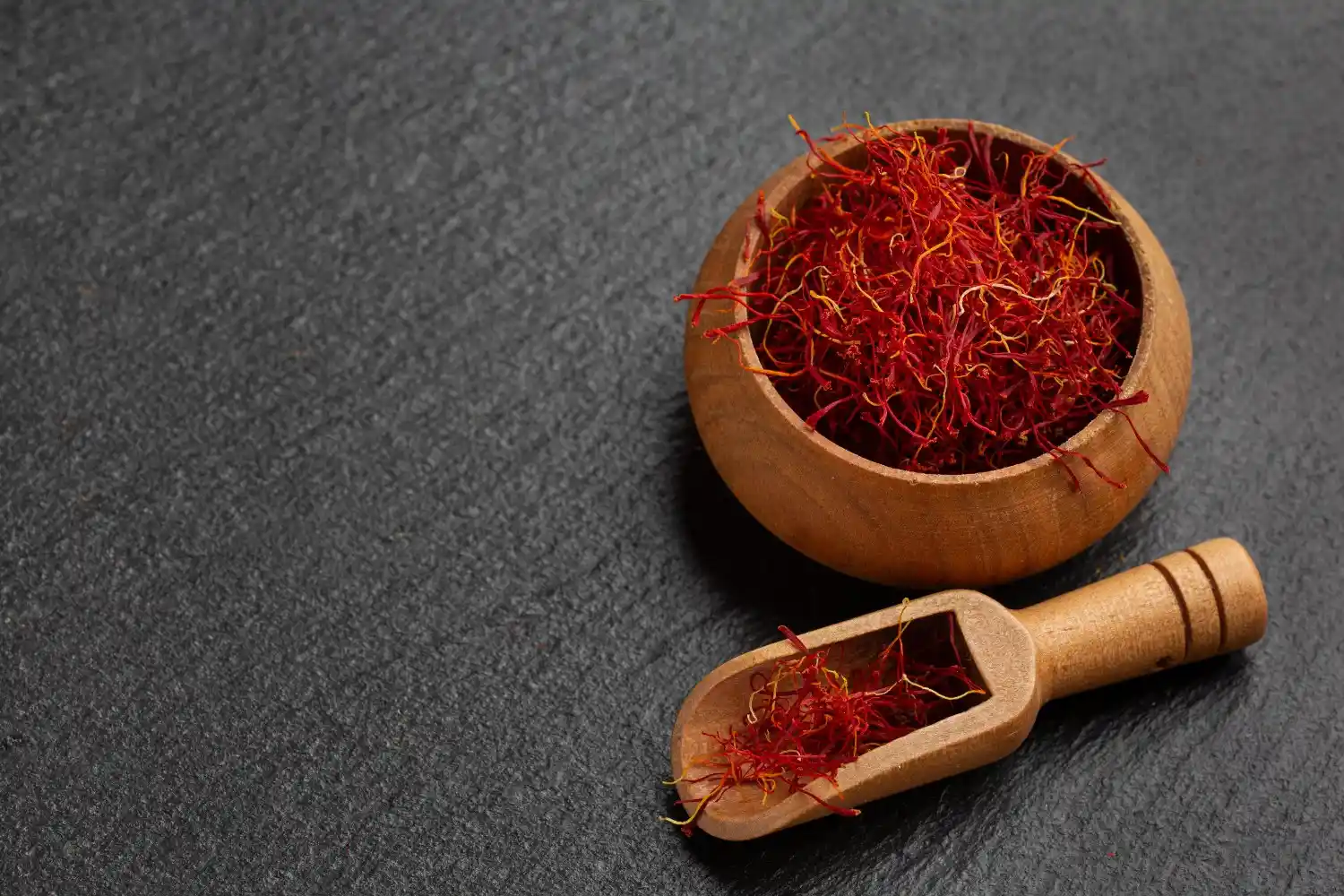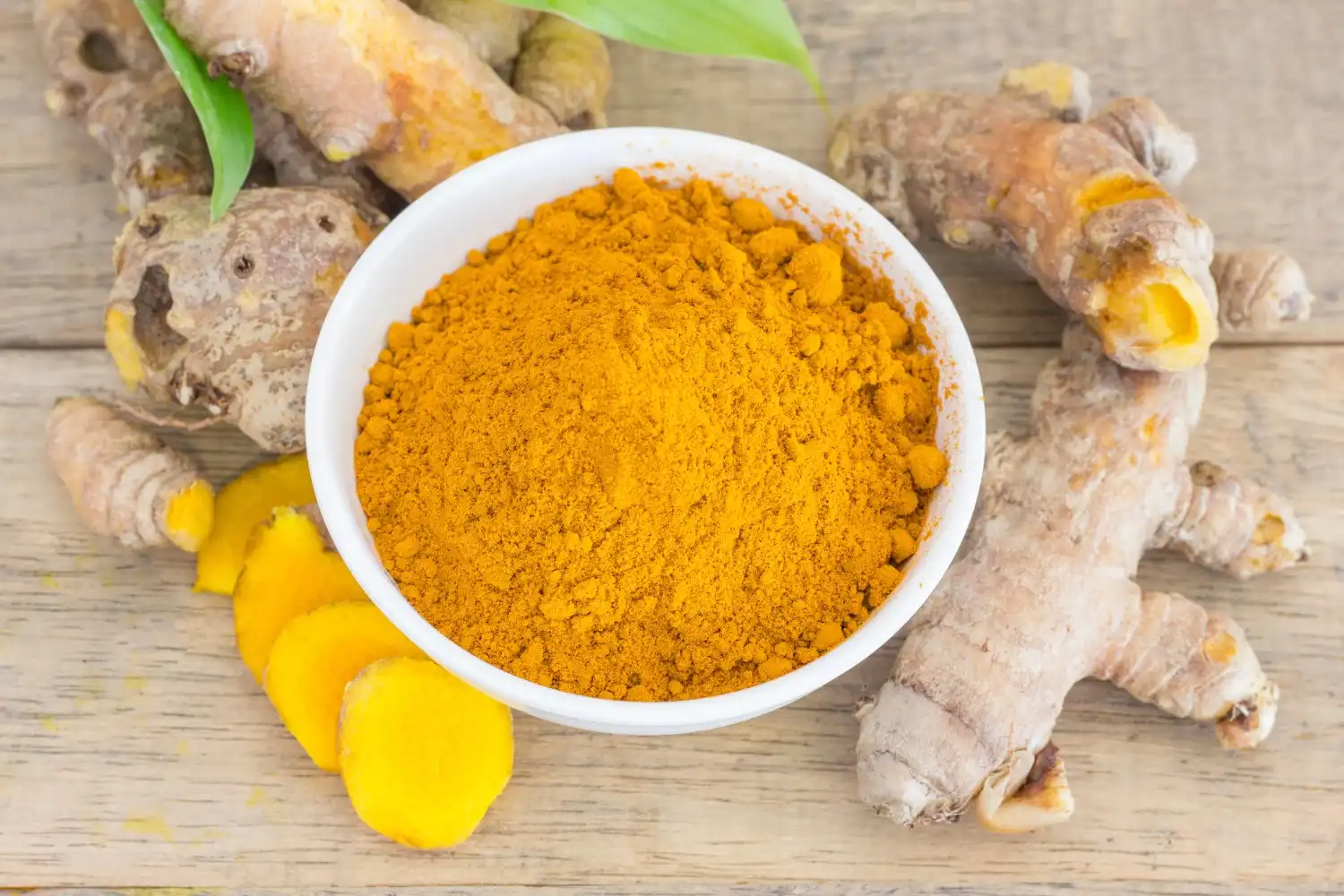Table of Contents
If you are comparing saffron vs turmeric, the two spices may look similar in the way they color food, but they are very different in origin, cost, nutrition, and health benefits.
Saffron is prized for mood and brain support, while turmeric is widely used for its anti-inflammatory and joint health effects.
Key Summary:
Saffron and turmeric are two powerful spices with very different strengths. Saffron is more closely linked to mood, brain health, vision, and reproductive wellness. Turmeric, on the other hand, is widely recognized for its anti-inflammatory, antioxidant, joint, and metabolic benefits. While saffron is rare and expensive, turmeric is affordable and easy to use daily.
What is Saffron?
 Saffron is the dried stigma of the Crocus sativus flower, often called the “gold of spices” because of its high cost and delicate flavor. It contains active compounds like crocin and safranal, which are linked to antioxidant and mood-supporting benefits.
Saffron is the dried stigma of the Crocus sativus flower, often called the “gold of spices” because of its high cost and delicate flavor. It contains active compounds like crocin and safranal, which are linked to antioxidant and mood-supporting benefits.
Harvesting saffron is extremely labor-intensive, as each flower produces only three tiny stigmas that must be picked by hand.
This explains why saffron is the most expensive spice in the world. Beyond its use in traditional Persian, Indian, and Mediterranean medicine, saffron is studied today for potential roles in improving mood, supporting eye health, and reducing oxidative stress.
What is Turmeric?
 Turmeric is a bright yellow spice made from the root of the Curcuma longa plant, a member of the ginger family. Its main active compound, curcumin, is known for powerful anti-inflammatory and antioxidant effects.
Turmeric is a bright yellow spice made from the root of the Curcuma longa plant, a member of the ginger family. Its main active compound, curcumin, is known for powerful anti-inflammatory and antioxidant effects.
Turmeric has been used in Ayurveda and Chinese medicine for thousands of years, especially for joint pain, digestion, and skin health.
Today, turmeric remains one of the most researched natural supplements, with evidence suggesting benefits for arthritis, heart health, and metabolic balance.
It is inexpensive, widely available, and often paired with black pepper to improve curcumin absorption.
Saffron vs Turmeric at a Glance
Both spices are valued for their health effects, but they differ in plant origin, compounds, and cost.
Saffron vs Turmeric: Nutrition Comparison
Saffron and turmeric both contain vitamins, minerals, and antioxidants, but their active compounds drive most of their benefits. Saffron provides more vitamin C and certain B vitamins, while turmeric offers more minerals like iron, potassium, and magnesium.
Although both are nutrient-rich, people typically consume them in small amounts, so their health impact comes mainly from bioactive compounds like crocin and curcumin rather than macronutrients.
Health Benefits of Turmeric
 Turmeric’s main compound, curcumin, has been widely studied for its role in calming inflammation, protecting cells, and supporting brain, heart, and metabolic health.
Turmeric’s main compound, curcumin, has been widely studied for its role in calming inflammation, protecting cells, and supporting brain, heart, and metabolic health.
Anti-Inflammatory and Joint Health
Curcumin helps turn down inflammatory signals that drive joint pain and stiffness.
Research has found that people with knee osteoarthritis often report less pain and better movement when taking curcumin (1). In many trials, its effect was similar to common pain medications but with fewer side effects.
Reviews also show consistent drops in inflammation markers like CRP and IL-6, which match up with the improvements users feel (2).
Antioxidant Support
Oxidative stress speeds up aging and damages tissues.
Studies show curcumin can raise the body’s overall antioxidant capacity and boost enzymes such as SOD, while reducing harmful byproducts like MDA (3).
This shift gives cells better protection against everyday stress and damage.
Brain and Mood Support
Curcumin may also support mental well-being.
Clinical studies have reported modest improvements in depressive symptoms, and short-term use has been linked to higher levels of BDNF, a protein that supports memory and learning (4).
While it’s not a replacement for medical treatment, curcumin shows potential as a helpful add-on for mood and brain health.
Heart and Metabolic Health
Curcumin appears to influence several heart and metabolic factors at once.
Research shows small but steady improvements in cholesterol levels, blood pressure, arterial flexibility, fasting blood sugar, and insulin resistance (5).
These benefits are especially seen in people with type 2 diabetes or higher cardiovascular risk, making curcumin a valuable support when paired with healthy lifestyle habits.
Health Benefits of Saffron
 Saffron’s main compounds, crocin, crocetin, and safranal, are linked to benefits for mood, eye health, reproductive wellness, and overall antioxidant protection.
Saffron’s main compounds, crocin, crocetin, and safranal, are linked to benefits for mood, eye health, reproductive wellness, and overall antioxidant protection.
Mood and Mental Health
Saffron stands out among natural remedies for mood support.
Studies show it can reduce depressive symptoms compared to a placebo and, in some cases, perform similarly to standard medications for mild to moderate depression (6).
Other research highlights its role in easing anxiety and improving sleep quality, even in people under everyday stress (7).
Eye and Cognitive Support
Early trials suggest saffron may help protect vision.
Doses around 30 mg daily have improved retinal function in people with early age-related macular degeneration, with benefits lasting for months (8).
Some small studies also indicate saffron may support memory and slow cognitive decline, although more large-scale research is needed (9).
Antioxidant and Anti-Inflammatory Effects
Saffron contains natural carotenoids and aromatic compounds that fight oxidative stress and lower inflammation.
Human studies show improvements in biomarker profiles, supporting its traditional use for protecting tissues and calming the body (10).
While the results are promising, researchers note that longer studies are needed to confirm its full impact.
Sexual and Reproductive Health
Saffron has been tested for its effects on sexual and reproductive health, especially in cases linked to medication side effects or hormone cycles.
Studies report improvements in erectile function in men and better arousal, lubrication, and comfort in women (11).
Additional research shows saffron may help relieve premenstrual symptoms and PMDD, with good short-term safety (12).
Saffron vs Turmeric: Which Is Better?
Saffron and turmeric are not direct substitutes; each shines in different areas. Saffron is better known for mood, brain, and reproductive health, while turmeric is stronger for inflammation, joints, and metabolic balance.
Saffron may be better if:
You’re looking for natural support with mild to moderate depression or anxiety.
Eye health or early macular degeneration is a concern.
You want help with PMS or sexual wellness.
You prefer smaller, concentrated doses with noticeable mood effects.
Turmeric may be better if:
You need support for arthritis, joint pain, or chronic inflammation.
Heart and metabolic health (cholesterol, blood sugar) are your focus.
You want a daily, affordable spice with broad antioxidant benefits.
You’re interested in brain support linked to curcumin and BDNF.
Risks and Side Effects
Both saffron and turmeric are generally safe in small amounts, but each has potential risks when taken in high doses.
Saffron is well tolerated in typical culinary or supplement servings, but large amounts can be toxic. Taking too much has been linked to nausea, dizziness, and even more serious complications, which is why supplements should stay within studied safe ranges.
Turmeric is usually safe but can cause stomach upset, bloating, or diarrhea in some people, especially at high doses.
Because curcumin may thin the blood, it can interact with blood-thinning medications and should be used with caution before surgery.
As with any supplement, people with medical conditions or who are pregnant should speak with their doctor before regular use.
Can You Take Saffron and Turmeric Together?
-v1756350149264.webp) Yes, saffron and turmeric can be taken together, and many supplements combine them for complementary benefits. Saffron targets mood, brain, and reproductive health, while turmeric focuses more on inflammation, joints, and metabolic support.
Yes, saffron and turmeric can be taken together, and many supplements combine them for complementary benefits. Saffron targets mood, brain, and reproductive health, while turmeric focuses more on inflammation, joints, and metabolic support.
Taken together, they provide a broader range of antioxidants and bioactive compounds.
Early research suggests there’s no conflict between the two, but it’s best to stay within safe daily amounts and consult a healthcare professional if you are on medication or managing a chronic condition.
Conclusion
Saffron and turmeric are two very different spices with powerful health potential. Saffron stands out for its effects on mood, mental health, eyes, and reproductive wellness, while turmeric is better researched for inflammation, arthritis, and cardio-metabolic support.
Neither is universally “better”; the right choice depends on your personal goals.
For many people, a combination of both can offer the widest range of benefits. Used mindfully, these ancient spices can play a modern role in supporting health and well-being.
FAQs
Is saffron stronger than turmeric?
Saffron is considered “stronger” for mood and mental health, while turmeric is stronger for inflammation and joint health. Each has different active compounds, so their effects are not directly comparable.
Which is better for depression, saffron or turmeric?
Studies suggest saffron shows more consistent benefits for mild to moderate depression, sometimes comparable to prescription medications. Turmeric may help mood as well, but its evidence is stronger in inflammation-related conditions.
Can saffron replace turmeric in supplements?
No, saffron cannot fully replace turmeric because they act on different pathways. Saffron is best for mood and reproductive health, while turmeric targets inflammation, joints, and metabolism.
How much saffron or turmeric should you take daily?
Most saffron supplements use 30 mg daily, which is the amount shown to be effective in many studies. For turmeric, clinical studies often use 500–1,000 mg of curcumin extract daily, usually paired with black pepper for better absorption.
Is it safe to use saffron and turmeric long-term?
Both saffron and turmeric appear safe in studied doses when taken regularly. However, high amounts can cause side effects, so long-term use should stay within recommended ranges and be discussed with a healthcare provider if you take medications.



